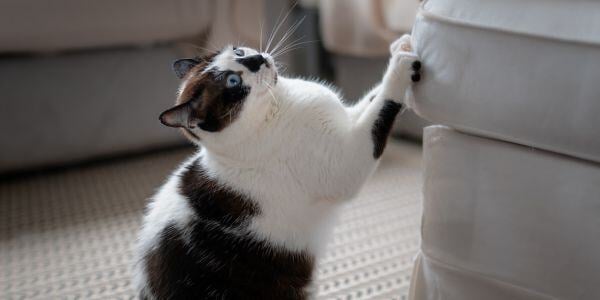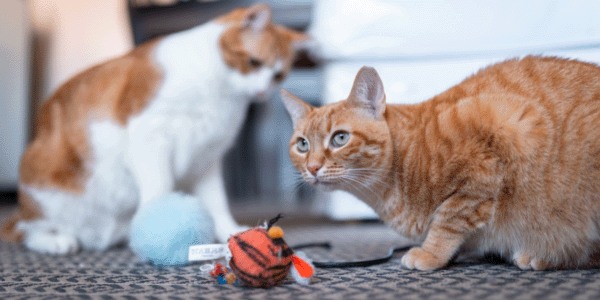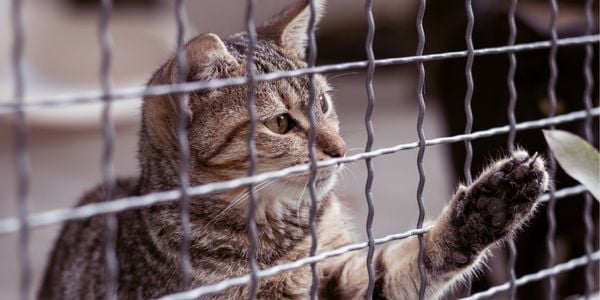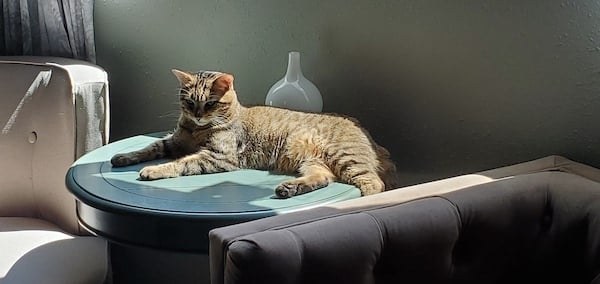 There are different reasons you may need to transition a cat from outdoor to indoor, or even just more indoor time than they’re used to.
There are different reasons you may need to transition a cat from outdoor to indoor, or even just more indoor time than they’re used to.
Maybe you’ve befriended a neighborhood stray that you want to adopt.
Your cat may need to spend less time outside as they get older or are recovering from a medical issue.
Sometimes, safety is a factor. If a pack of coyotes moves into your neighborhood, it might be time for your cat to stay inside. Even moving from a rural area to the city can mean a change in your cat’s outdoor time.
How to Transition an Outdoor Cat to Living Indoors Full-Time
How can you take your cat through this transition without upheaving your household? Your cat probably has a routine that includes sleeping in the sun, chasing and hunting various critters, and sniffing and investigating new things.
Suddenly changing that routine and losing that enrichment can make an unhappy cat. And we all know that an unhappy cat can mean an unhappy household. That’s why it’s important to tackle this big change with your cat’s needs in mind.
Many debate about whether being an indoor or outdoor cat is better. I have my take on it, which you can read later on in this article, but ultimately, this is a personal decision, and there are pros and cons to both feline lifestyles.
'Why Can’t I Just Bring My Cat Inside and Keep the Door Closed?'
You can. But it may not be pleasant. Like people, cats learn how to get what they need through experience. If your cat wants to go outside but suddenly isn’t able to, it’s only natural for them to start meowing or doing other things to get your attention.
They’re not trying to drive you crazy. They just don’t understand why their routine has suddenly changed and are trying to get what they need — that door open.
All the explanations and pleading in the world won’t help your cat understand why they’re inside when they want to be outside. And punishment will just make things worse.
All of this means stress for them, which can come with a host of issues like cats not getting along as well, soiling, overgrooming, and even health issues. And it means stress for you as your cat uses unwanted, attention-seeking behaviors like vocalizing to try and get your attention.
The good news is that you can help your cat transition indoors with just a little planning and effort.

Getting Your Cat to Enjoy Coming Inside
For the purposes of this article, we’re assuming the cat you want inside is friendly with people, fine with any other pets you have, and has been cleared medically. If you’re working with a stray or feral cat or one who’s friendly with you but not your resident cat, there’s more you need to consider.
Today, we’re just focusing on making inside a good thing.
It's a gradual process:
Ideally, this is a gradual process, slowly keeping your cat indoors for longer periods and giving them positive reasons to want to be there. If you’re in a situation where your cat suddenly needs to be indoors at all times, don’t worry. We’ll give you some tips for that later in the article.
Use things your cat loves:
Start by finding a few things your cat goes nuts for. Maybe it’s a special treat, some catnip, a favorite new toy, or just some really great bonding time like a play or cuddle session.
Pick and stick with certain times of day:
Next, pick a time (or multiple times) when your cat is outside to try and encourage them to come in. If they spend most of the day outside, maybe you pick a midday time and an evening time. If your cat comes in on their own at mealtime, use that as your starting point. You want to stick with those times so your cat learns, “OH, it’s time to go in and get my favorite things.”
Don't pick up your cat to bring them inside:
At those times, encourage your cat to come inside in whatever way generally works. Some cats come when called. Others may come on their own. Or you may need to go find your cat in the yard.
Don’t carry them in. Let them choose to come in. Why would they do that? Because they’re going to get a little party when they do — their favorite treat, that special toy, a petting extravaganza. Give them a reason to CHOOSE to come inside.
Let them go back outside – if they want:
If they want to go back outside after the party, meal, or whatever brought them in, let them do so. But you’ll slowly increase the time they’re inside.
For example, if they usually come in for lunch and then go back out 15 minutes later, have them come in for lunch, throw the “coming inside is a great thing” party, let them eat, then let them out 25 minutes later. After a few days, it’s 40 minutes later. Then, an hour later. And so on.
This same approach can work if you just want to teach your cat to come inside around the same time every day, for instance, before dark, when it gets more dangerous for them to be outside. You’d just pick that single time and focus on giving your cat reasons to come in at that time each day.

Getting Your Cat to Enjoy Staying Inside
Getting them in is one thing. Making it someplace they enjoy and want to stay is another.
As the time inside increases, or if they get a little anxious wanting to go out, redirect their attention to something positive, like a short play session, treat hunt, food puzzle, or battery-powered toy.
They’re getting used to being inside slowly, so it’s not a sudden, unsettling change. They’re learning that really good stuff happens when they come in. And it’s not stressing you out because they’re not desperately trying to get back outside.
In time, your cat will settle into the new routine, and you won’t need to throw a "party" or keep them distracted. However, it’s still always good to reward wanted behaviors, like coming in when called or being relaxed when inside, with something positive.
Increase Physical and Mental Enrichment
There’s another piece of this puzzle that’s vital. Your cat is losing lots of physical and mental enrichment by staying inside. You need to replace that good stuff to keep your cat’s energy level under control, meet the instinctual needs they’re no longer meeting on their own outside (like hunting), and keep their quality of life high.
Prey sequence play sessions are one of the best ways to do this. We have a whole article on incorporating this kind of "hunting" play with your cat.
Mental enrichment is another great option. This includes anything that gets your cat moving or using their brain. Food puzzles, chasing or hunting treats, training sessions, and so many other things are great enrichment opportunities that don’t take much time from you.
We have lots of ideas and product recommendations in our articles on What to Do if Your Cat Gets Bored and Different Types of Cat Toys.
There are also a couple of fun books on the subject: Brain Games for Cats and Beyond Squeaky Toys
Before you know it, your cat is spending large chunks of time inside, you’re enjoying fun new ways to engage with your cat through play and enrichment, and everyone is feeling great about the change.
When You Have to Make an Urgent Change to Indoors
You may not have the luxury of a slow transition. If there’s a sudden danger outside or your cat is dealing with a medical issue, for example, outside time may need to end with no leeway. In these cases, really lean into the idea of play and enrichment, as described above. Give your cat something to do at the times they’d normally head outside.
Keep their minds and bodies active and occupied to lessen the impact of this big change. And be patient. Imagine if you suddenly lost access to something you love that you did every day. It has an impact.
If you know a change is coming — for example, you’re moving in a month and outside access isn’t available at the new home — start making gradual changes before the move (or whatever the event is). Make the change pre-emptively so it’s not as sudden when the time comes.

Safer Outdoor Alternatives
Just because your cat can’t free-roam outside doesn’t mean they can’t spend time outside safely. Here are some things you can try:
-
Teach your cat to walk on a harness and leash. Be sure to check out our articles on this topic so you can avoid dangers, and train your cat is a really positive way to be comfortable wearing the harness.
-
Try a cat stroller. These are fully enclosed cat carriers with wheels. Backpacks are another option, but I’m not a fan. Having your cat on your back means you can’t see how they’re doing, and they’re getting jostled around a lot. With a stroller, your cat has plenty of room to move. They’re in front of you, so you can react quickly if they seem stressed or afraid, and you can easily cover part of the stroller if they get nervous.
You’d use the same slow, positive training process as harness training or getting your cat used to being in their carrier to help your cat get used to the stroller and being outside in it. -
Get or build a catio. Catios are enclosed structures where your cat can spend time outside more safely. They range from small, fabric, pop-up enclosures to mid-sized, wooden, and chicken wire setups (similar to a chicken coop) to full buildouts that resemble an enclosed patio. You can find options for any budget.
They can be permanent, movable, and even collapsible. Here’s a great source for DIY catio plans if you want to build your own.

If Transitioning to Indoors Is Not Going Well
If your cat isn’t handling their transition well, you may notice things like:
- Vocalizing or other attention-seeking behaviors
- Sleeping all day and keeping you up at night
- Disinterest in play and/or attention
- Changes to eating, drinking, or litter box behavior
- Any other concerning changes in their normal behavior
Consider working with a certified feline training and behavior consultant. They can help you figure out why your cat is struggling and give you recommendations to help. These may include things like adjustments to their environment, ways to encourage them to play, calming supplements, addressing inter-cat relationship issues, and general stress reduction.
The Indoor/Outdoor Cat Debate
I’m not here to tell you what to think about indoor-only cats. Some people feel it’s safe and responsible to keep cats inside. They can live healthier, longer lives without being exposed to the dangers of modern life outdoors.
On the other hand, many people believe that it goes against a cat’s nature to be inside all the time, and they have a better quality of life if they’re able to spend time outside.
Personally, I think both are true, which is why it’s a continual mental and emotional battle in my head. You need to do what’s best for your cat and your family, taking into account things like the safety of the area, your cat’s medical and vaccination status, etc.
Regardless of your take on indoor-only, there may be times or circumstances when your cat needs to stay inside, come in at a specific time each day, or just spend more time inside. Using the steps in this article will help with the transition.






